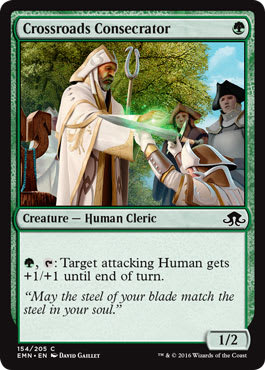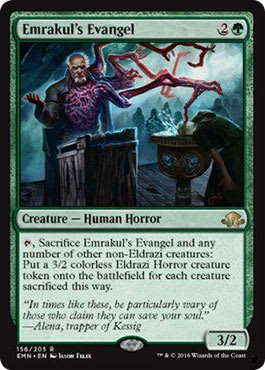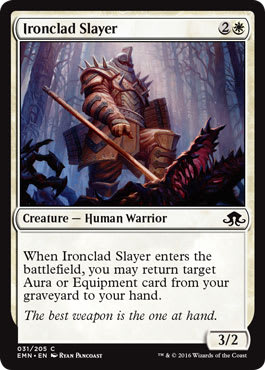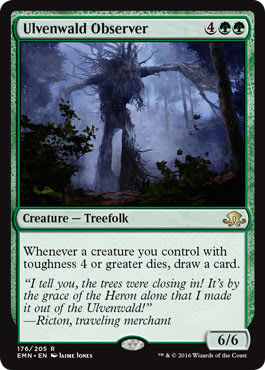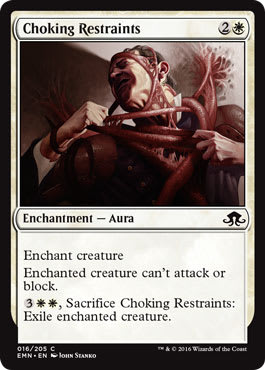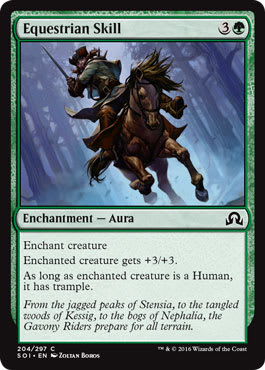We’ve got a fun one this week with Ertai’s Meddling! Today we’re going to be looking at Weapons and Wards, a tribal deck with an augmentation subtheme. These sorts of decks don’t always work as planned, since the notion of using auras to build up your creatures can leave you vulnerable to getting punished by your opponent when they solve two of your cards with one of theirs. But today’s build is especially exciting thanks to a single card, Open the Armory, which will let us build a toolbox deck.
The Meddling series is where we take a preconstructed deck, strip it down to its essential, then rebuild it subject to two Golden Rules.
- We can only add commons and uncommons.
- The cards we add must be from the same sets found in the deck (in this case, Shadows over Innistrad and Eldritch Moon)
This keeps the deck affordable and easy to assemble. We’ll begin with a look at the stock decklist, then we’ll start making our cuts!
Weapons and Wards ?Eldritch Moon Intro Pack | Wizards of the Coast
- Creatures (21)
- 1 Courageous Outrider
- 1 Emrakul's Evangel
- 1 Inspiring Captain
- 1 Militant Inquisitor
- 1 Sigardian Priest
- 1 Steadfast Cathar
- 1 Ulvenwald Observer
- 2 Crossroads Consecrator
- 2 Fiend Binder
- 2 Hamlet Captain
- 2 Intrepid Provisioner
- 2 Ironclad Slayer
- 2 Subjugator Angel
- 2 Thraben Standard Bearer
Call the Troops
Before we can add anything to the deck, we need to take some things away. What to cut? To find out, let’s first look at the deck and what it’s trying to accomplish. Weapons and Wards has a pretty concrete theme.
First, it’s Human tribal. Outside of a Treefolk and pair of Angels at the top of the mana curve, every one of the deck’s twenty-one creatures is a Human. You have a number of reasons to load up on the Humans.
- Some creatures have special abilities that work best when you’re playing a lot of Humans, such as Hamlet Captain and Courageous Outrider
- Some auras offer enhanced effects if the recipient of the spell is a Human, such as Hope Against Hope and Equestrian Skill
- Interestingly, one of the deck’s two rares, Emrakul's Evangel, completely pitches this theme out of the window by changing your Humans into Eldrazi Horrors
In short, the deck performs at its best when you’re able to rely on a critical mass of Humans for your creatures. But as with many of these Intro Packs, there’s also a secondary theme we’ll want to consider: creature enhancements. Although there is a high proportion of creatures, this isn’t a classic White Weenie/swarm kind of deck. Those decks tend to go broad, meaning you deploy more threats than your opponents have answers for, and look to overrun them. In an enhancement deck, you deploy fewer threats, but have other ways to make them punch above their weight.
Just as with the Humans theme, Weapons and Wards has some synergy and overlap with its augmentations.
- Ironclad Slayer retrieves an Aura or Equipment from your graveyard
- Militant Inquisitor gets a power boost for every Equipment you control
- Strength of Arms, a combat trick, gives you a bonus 1/1 Human Soldier if you control a piece of Equipment
- Open the Armory lets you tutor for an Aura or Equipment
As it turns out, there’s room aplenty for both themes in a Meddled deck, but for the creatures there is plenty of fat to trim. We’re also going to want to bring down the average converted mana cost of the deck, preferring to run creatures early, use the midgame to reinforce them and outrace our opponent. We have to ask ourselves, what are the creatures that will most help us to get there?
First to go is the Crossroads Consecrator. This isn’t an easy cut, as he checks a few boxes we’d like to see. First, he’s Human, which is a gimme. But he also has some synergy with the tribe, offering a +1/+1 bonus to an attacking Human. This seems like a modest bonus, but there’s an added effect that these sorts of creatures offer, and that’s in added challenge to your opponent when weighing blocking assignments. When any of your attackers could suddenly be +1/+1 larger, that can change the dynamic of the battle- sometimes considerably. Some lethal blocks will become trades; some trades will become an actual loss of their creature.
The problem is that you’re devoting an entire creature to the onboard combat trick. The Consecrator has fine stats for a 1-drop, able to block and kill any 1/1’s your opponent sends after you for early damage. But this is an example of a card that gets its pink slip not because it’s ‘bad,’ but rather because for our purposes, it just doesn’t bring enough to the table.
The same factors go into consideration for releasing the Thraben Standard Bearer. It’s a 1-drop 1/1 that lets us convert useless cards into 1/1 Soldiers. What are useless cards? Usually, that means land we draw later in the game when we don’t need it anymore. That’s helpful, but there’s actually a better way to avoid drawing useless land later in the game. It’s called, killing your opponent sooner. We’ll want cards that do that, not this.
Next up is the Steadfast Cathar, which swings in as a 2/3 instead of its natural state, a 2/1. That’s useful, since we’ll be wanting to be attacking often, but it doesn’t bring anything else. The 2-3 mana slot is filled with useful creatures that add a little extra, such as the Hamlet Captain, and we only have only so many slots to offer.
Indeed, we actually hit a pocket of quality here with the original cards. The next cut we make isn’t until the Militant Inquisitor, another 2/3. The Inquisitor demands that we run Equipment to be useful, and while we will be running some, we’re not going all in to where we can make the Inquisitor a colossus.
From there, we drift into 4-drop territory. The Intrepid Provisioner is another card that, at first, seems like a good fit. Decently solid 3/3 body, relevant keyword, tribal ability . . . Unfortunately, it doesn’t compare as well to the Courageous Outrider, and a one-time buff is not quite as useful as card advantage. There is always a risk in front-loaded creature decks of running out of gas later in the game, so the nod has to go to the card that helps keep gas in the tank.
This also means that we’ll be cutting the Fiend Binder. Though tapping a defender each attack is a strong ability, it won’t help us until turn five at the very earliest (the first opportunity a Binder has to attack), and the body is a bit too weak for the mana. The same goes for the Inspiring Captain, which isn’t valuable enough of a package for the deck to consider keeping.
Finally, we’ll also be dispensing with the Subjugator Angel. The Angel is a useful closer, almost completely dropping your opponent’s defenses for a game-winning alpha strike. The problem is it costs 6 mana, and we can certainly get to a place of victory for less using the resources we already have, rather than waiting for an Angel.
Raise the Banners
So now that we’ve made our cuts, what are we keeping? There’s still plenty of good cards here, so mainly we’ll just be rounding them out from the usual collection of one-ofs and two-ofs into full playsets. We’ll start with the Hamlet Captain, which is an on-curve body that gives our other Humans a nice buff when its committed to an attack or defense. Since some of the auras and equipment we’ll be including can make creatures harder to block, the Captain will have a number of opportunities to grant his bonus over and over. We’ll take four, not least because having a second Captain attacking means they each get a partial boost.
Next is the Sigardian Priest. Above, we mentioned how the Crossroads Consecrator’s buff made combat math a little more complex for our opponent, since they could not be sure of where we’d apply the bonus until after they’d committed their blockers. The Priest does something very similar, but it affects the entire combat. Your opponent can’t commit their forces to attack and leave one creature back to block, because they know you’ll just tap it down. If your opponent dropped something substantial on the table, the Consecrator’s ability might not be enough to deal with it. The Priest’s often will be.
The tapping can also be done defensively if your opponent has the upper hand, preventing them from bringing their best attacker to bear. We’ll take four of these as well. Although using their ability takes them out of combat (since it taps them to activate), remember that this deck is going high, not wide. If we can use removal to disable some potential blockers, use Priests to care of others, that leaves the attack lanes relatively clear for our Voltron-esque Humans. This is not unlike the exalted mechanic from 2008’s Shards of Alara, which used a supporting cast to beef up a single attacker.
Our next addition is something completely new, the Duskwatch Recruiter. While the Werewolf form doesn’t add to the tribal synergy, the idea here is that the Human side does, and it brings some real gas to the tank. Being able to dig for creatures is a tremendous advantage, and if it happens to flip into the Werewolf form, it might no longer be Human, but its creature cost reduction will help you fill the board. The Recruiter is a slam dunk here, and we’ll be sleeving up a full playset of them.
Emrakul's Evangel is one of the deck’s two rares, and we almost never cut rares from a deck since they tend to be loud, swingy, and fun effects. The Evangel is no exception. In a way, this is the perfect analogy for the block, dropping the veneer of humanity when the time is right, and going for the kill. That’s what the Evangel does for you if you’ve gotten into a position where you have the numbers, but perhaps not the force. It’s not a stretch to imagine just needing a little extra power to close out the game, so you tap down a potential defender with the Sigardian Priest at the end of your opponent’s turn, exchange it for a 3/2 Horror, and hurling it into the red zone during your next combat.
We’ll also be keeping the Ironclad Slayer, which is another creature that offers the opportunity for card advantage. The problem with auras is that you tend to lose two cards to an opponent’s one when your creature is killed, setting you back. The Slayer can pull those cards back to your hand when it comes into play, giving you a second shot at using them. Since Equipment tend to be pretty durable (most folks don’t main-board artifact removal), this is mainly for your auras. It synergizes particularly well with Choking Restraints, since you can lock down a creature early, use the sacrifice ability to exile the creature and send the Restraints to the graveyard, and then cast the Slayer next turn and get the Restraints back. At 5 mana, it’s not something you’ll be doing every game, but it’s always good to have the option.
The next card we’ll be keeping is the Courageous Outrider. The Outrider gives you the ability to replace it in your hand when it enters the battlefield, and most of the time drawing four cards means you’ll be seeing at least one Human. I mentioned above that we’re more interested in going tall instead of wide, but there’s no reason we can’t have a little of both.
Finally, there’s the decks premium rare Ulvenwald Observer. This is a 6/6 Treefolk that lets you draw a card whenever a creature with toughness 4 or greater dies. That seems an odd fit in the deck, where almost none of the creatures fit the bill, but that’s where the creature augmentation is going to come in. By letting you draw a card, it takes a lot of the sting out of losing an enchanted creature. A 6/6 body is nice to have around, too.
Prepare for Battle
Thus far, we’re trimmed down the deck and streamlined it, sticking with the deck’s overall philosophy. We’re going to do the same thing with the deck’s non-creature supporting cards, with a twist.
A ‘toolbox deck’ in Magic is one that has a wide variety of utility cards that have different effects, rather than a straight four-of list. It’s wildly inconsistent, except that these sorts of decks often have ways of going and getting exactly what you want. That’s what makes the toolboxes. You can respond to a wide range of situations, because somewhere in your deck is the perfect card for the moment and you have a way to go get it.
The most well-known deck of this sort makes use of creatures with enters-the-battlefield or death triggers, along with Birthing Pod. As you use the Pod to get ever-bigger creatures, each one brings along a special effect. Thanks to an Eldritch Moon card, Open the Armory, we’re going to be building something similar here for Weapons and Wards.
Open the Armory is a singleton in the stock deck, but we’re ratcheting that up to four. This will let us run a variety of auras and equipment, since we can just tutor up the most applicable one when we need to. It’s a fantastic card, since it lets us be very flexible and responsive to changes on the battlefield. Need to remove a creature in a pinch? Tutor up Choking Restraints, which we’ll be carrying four copies of since we want more than one.
Or maybe grab a Faith Unbroken, which not only removes the threat you’re facing, but also buffs one of your creatures. Hope Against Hope is perfect for later in the game when you have a lot of creatures in play, since it gives a bonus for each creature you have on the battlefield. Oh, and first strike to boot, since your creatures are Humans.
On the other hand, if your opponent is managing to whittle away at your life total, you can tutor up the True-Faith Censer, which grants a stats boost and vigilance. That lets your best creature not only hit a little harder, but also stay back to help on defense. If the red zone is too congested, you can always go above it thanks to Gryff's Boon. Alternately, slap Equestrian Skill on and you can ride right over any chump-blockers. And since the hallmark of the toolbox archetype is being able to deal with corner cases and unlikely outcomes a little better than most, we’ll even throw in a single Neglected Heirloom to slap on to your Duskwatch Recruiters. There’s a bit of a gamble here since the card is fairly underwhelming in its natural state, but the upside of a 6/6, first-striking Krallenhorde Howler is tremendous.
And just to keep your opponent on their toes, we’ll also be adding in a pair of Expose Evil. This can expose a hole in their defenses your creatures will be only too happy to exploit, and thanks to investigate you’ll be able to cash in for a card later on when you find yourself with two extra mana.
So there you have it! A tribal Humans deck with an auras-and-equipment toolbox supporting frame that’s a lot of fun to play. Summon your troops, build them up with auras and equipment, and when some inevitably fall salvage the augments from the graveyard and do it all over again! Here’s the final decklist:
Meddled Weapons and Wards ? Eldritch Moon Standard | Jay Kirkman
- Creatures (20)
- 1 Emrakul's Evangel
- 1 Ulvenwald Observer
- 2 Courageous Outrider
- 4 Duskwatch Recruiter
- 4 Hamlet Captain
- 4 Ironclad Slayer
- 4 Sigardian Priest
- Spells (16)
- 2 Expose Evil
- 4 Open the Armory
- 1 Equestrian Skill
- 1 Faith Unbroken
- 1 Gryff's Boon
- 1 Hope Against Hope
- 4 Choking Restraints
- 1 Neglected Heirloom
- 1 True-Faith Censer
I’d love to hear your thoughts, or what direction you might have gone in the comments below.
I’ll be back next week with a feature on the newest Conspiracy release, but there’s one more Eldritch Moon Intro Pack to go!
















